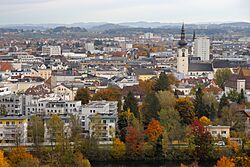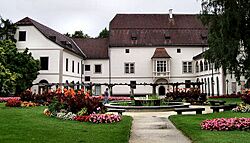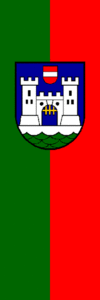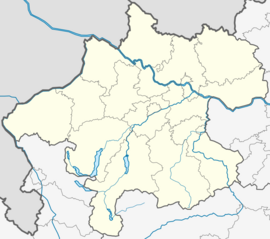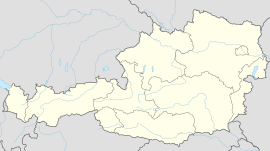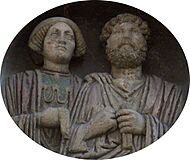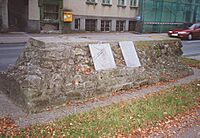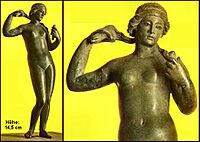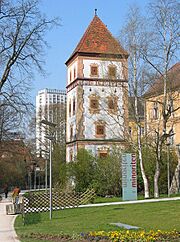Wels facts for kids
Quick facts for kids
Wels
Meta-Wös
|
|||
|---|---|---|---|
|
From top down, left to right: view of Wels from Thalheim, Stadtplatz in the city center, Ledererturm, city parish church, former savings bank, Burg Wels
|
|||
|
|||
| Country | |||
| State | |||
| District | Statutory city | ||
| Area | |||
| • Statutory city | 45.92 km2 (17.73 sq mi) | ||
| Elevation | 317 m (1,040 ft) | ||
| Population
(2018-01-01)
|
|||
| • Metro | 88,577 | ||
| Time zone | UTC+1 (CET) | ||
| • Summer (DST) | UTC+2 (CEST) | ||
| Postal code |
4600–4606
|
||
| Area code | 07242 | ||
| Vehicle registration | WE | ||
| Website | www.wels.at | ||
Wels is a city in Upper Austria, located on the Traun River near Linz. It is the main city of the Wels-Land area. With about 60,000 people living there, Wels is the eighth largest city in Austria.
Contents
Discover Wels: Location and Landscape
Wels is found in a region called the Hausruckviertel. It sits at an elevation of about 317 meters (1,040 feet) above sea level. The city stretches about 9.5 kilometers (5.9 miles) from north to south and 9.6 kilometers (6.0 miles) from west to east. A small part of the city, about 3.4%, is covered by forests, while 23.5% is used for farming.
City Parts: Neighborhoods of Wels
The city of Wels is made up of many different neighborhoods. These include Aichberg, Au, Berg, Brandln, Dickerldorf, Doppelgraben, Eben, Gaßl, Höllwiesen, Hölzl, Kirchham, Laahen, Lichtenegg, Mitterlaab, Nöham, Niederthan, Oberhaid, Oberhart, Oberlaab, Oberthan, Pernau, Puchberg, Roithen, Rosenau, Schafwiesen, Stadlhof, Trausenegg, Unterleithen, Waidhausen, Wels, Wimpassing, and Wispl.
Wels Through Time: A Brief History
Wels has a very long and interesting history. People have lived in this area for thousands of years.
Ancient Times: Early Settlements
The first signs of people living in Wels date back to the Neolithic era, which was between 3500 and 1700 BCE. Simple tools found near the Traun River show that early communities lived here.
Bronze Age Discoveries
A Bronze Age cemetery was found near the current airport. It dates back to the Urnfield Culture (1100–750 BCE). This cemetery had 60 graves with bronze jewelry and food items.
Iron Age Finds
Swords from the Halstatt Period (750–400 BCE) have been discovered in the Pernau area. Later, during the Iron Age La Tène culture (up to 100 BCE), Celts lived here. They left behind gold coins, swords, pottery, and iron brooches. The name "Traun" comes from this time. It is also possible that the name "Wels" comes from a Celtic word meaning "Settlement on the bend of the Traun River."
Roman Era: Ovilava's Importance
Wels became very important during Roman times. It was centrally located in the province of Noricum. Around 120 CE, Wels was given Roman city rights and named Municipium Ovilava. The main part of the city was near the Traun River, where Kaiser-Josef-Platz is today. It had brick houses, a public bathhouse, an arena, and a system that brought clean mountain water into the city.
Becoming a Roman Colony
Around 215 CE, during the rule of Emperor Caracalla, the city was renamed Colonia Aurelia Antoniana Ovilabis. It was given the special status of a Colonia. At this time, about 18,000 people lived in the city.
City Defenses and Governance
Because of threats from tribes like the Alemanni, a city wall was built around Wels. This wall covered an area of about 90 hectares (222 acres). A road was also built along the Danube River to Passau. The city walls had six towers with gates. These gates controlled who could enter the city from the western road, towards the Traun River, and from the fields outside the city.
Emperor Diocletian made Ovilava the capital city of the province of Noricum Ripensis. The city was run by two duumviri (judges), two aediles (who made sure laws were followed), a quaestor (who managed the city's money), and a city council with 100 members.
Ovilava managed a large area between the Inn and Danube rivers. This area stretched from Lauriacum (Enns) in the east to Bad Ischl in the west. It included border forts, cities like Linz (Lentia) and Passau (Boiodurum), and many settlements in what are now Upper Austria and Salzburg.
Decline of Roman Wels
During the early migration period (3rd, 4th, and 5th centuries), the area around Ovilava was often attacked by tribes like the Alamanni and Vandals, and by Attila's army. By the time of Emperor Gallienus, the province of Noricum was described as "devastated." Later, under Odoacer, the first Germanic King of Italy, Noricum was called "vacant." From the 4th century onwards, Wels likely became a small, unimportant village for several centuries.
Roman Wels: Economy and Trade
The economy of Roman Ovilava was based on farming and local trade. Most farming was for people to feed themselves. However, cows and horses were raised in large numbers and sold to other places. The oldest granary (a place to store grain) in the Eastern Alps was found in Wels. It held different grains like wheat, dwarf wheat, emmer wheat, barley, and rye. There were also important workshops for making bricks and pottery, as well as mines for building stone.
Because Wels was located at a key crossing point for several Roman roads, many items from other parts of the Roman Empire have been found there. These include Terra Sigillata pottery and small statues (like the "Venus of Wels") from Gaul and Germania Inferior. Oyster shells and coins from Italy have also been discovered.
Middle Ages: Wels as a Trading Hub
Wels was a small trading center during the Middle Ages. In 943, the Hungarians were defeated by the Bavarians and Carantanians in the Battle of Wels. In 1222, under the rule of the Babenberger family, Wels was again granted city rights. A document from 1328 shows that Wels was an important market town. Its special economic rights and good location near several rivers helped it become a significant place in the region.
Emperor Maximilian I died in Wels on January 12, 1519. This happened after the people of Innsbruck would not let him into their city.
20th Century: Modern Wels
During World War II, a small part of the Mauthausen concentration camp was located here.
On January 18, 1964, Wels officially became a Statutarstadt of Austria. This means it is a city with its own special legal status, acting as both a city and a district.
Population Growth in Wels
| Historical population | ||
|---|---|---|
| Year | Pop. | ±% |
| 1869 | 11,704 | — |
| 1880 | 13,175 | +12.6% |
| 1890 | 14,735 | +11.8% |
| 1900 | 17,308 | +17.5% |
| 1910 | 22,015 | +27.2% |
| 1923 | 24,248 | +10.1% |
| 1934 | 25,956 | +7.0% |
| 1939 | 29,533 | +13.8% |
| 1951 | 38,120 | +29.1% |
| 1961 | 41,060 | +7.7% |
| 1971 | 47,527 | +15.8% |
| 1981 | 51,060 | +7.4% |
| 1991 | 52,478 | +2.8% |
| 2001 | 55,478 | +5.7% |
| 2011 | 58,713 | +5.8% |
| 2014 | 59,339 | +1.1% |
Economy and Education in Wels
About 36,000 people work in Wels. Around 63% of these jobs are in the service sector, like shops and offices. Wels is known as an important city for shopping. It also has several gymnasiums (academic secondary schools) and higher vocational schools. These schools help students prepare for university or specific careers. Wels is also famous for the Wels Fair, a large event that happens every year in autumn and spring.
Famous People from Wels
Many notable people have connections to Wels.
Artists and Thinkers
- Alois Auer (1813–1869), a printer, inventor, and artist who drew plants.
- Heinrich Brunner (1840–1915), a historian.
- Hugo Gerard Ströhl (1851–1919), an expert in heraldry (the study of coats of arms).
- Carl Rabl (1853–1917), a doctor and expert in anatomy.
- Julius Wagner-Jauregg (1857–1940), a doctor who won the Nobel Prize in Physiology or Medicine in 1927.
- Grete Hinterhofer (1899–1985), a classical pianist and composer.
- Walter Kolneder (1910–1994), a music expert and violist.
- Josef Friedrich Doppelbauer (1918–1989), a composer, organist, and choir conductor.
- Thomas Christian David (1925–2006), a composer and musician.
- Werner Kreindl (1927–1992), a television actor.
- Karl Ridderbusch (1932–1997), an opera singer who lived and died in Wels.
- Herbert Lindinger (born 1933), a graphic artist and designer of trains and trams.
- Lukas David (1934–2021), a classical violinist.
- Karin Hannak (born 1940), an artist.
- Sybil Danning (born 1947), an Austrian–American actress and model.
- Manfred Buchroithner (born 1950), a mapmaker, geologist, and professor.
- Christoph Ransmayr (born 1954), a writer.
- Thomas Steiner (born 1956), a film director.
- Franz Welser-Möst (born 1960), a famous conductor who grew up in Wels.
- Stefan Sonvilla-Weiss (born 1961), a communication scientist and educator.
- Götz Spielmann (born 1961), a film director and screenwriter.
- Sabine Derflinger (born 1963), a director, writer, and producer.
- Norbert Trawöger (born 1971), a flautist and artistic director.
- Christoph Wigelbeyer (born 1973), a choir director, conductor, singer, and music teacher.
Public Figures
- Paul Rübig (born 1953), a politician who was a member of the European Parliament.
- Othmar Commenda (born 1954), a retired General of the Austrian Armed Forces.
- Rudolf Anschober (born 1960), an Austrian politician.
Sports Stars
- Max Hagmayr (born 1956), a retired footballer who played many games and also for the Austrian national team.
- Christoph Sieber (born 1971), a sailor who won a gold medal at the 2000 Summer Olympics.
- Christian Mayrleb (born 1972), a footballer and top scorer in the top division, who also played for Austria.
- Johannes Wipplinger (born 1978), an athlete and bobsledder.
- Helge Payer (born 1979), a football goalkeeper who played many games for Austria.
- Robert Žulj (born 1992), a footballer who has played over 300 games.
- Kevin Wimmer (born 1992), a football player who has played many games for Austria.
- Felix Großschartner (born 1993), a cyclist.
- Peter Žulj (born 1993), a footballer who has played over 300 games and for Austria.
- Marcel Sabitzer (born 1994), a footballer who has played many games for his club and for Austria.
- Shamil Borchashvili (born 1995), an Austrian judoka who won a bronze medal at the 2020 Summer Olympics.
See also
 In Spanish: Wels para niños
In Spanish: Wels para niños


